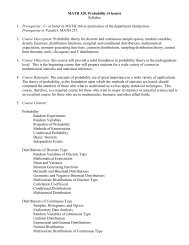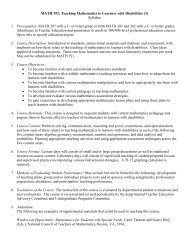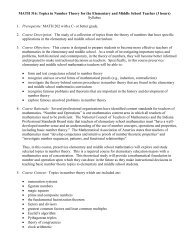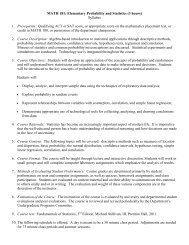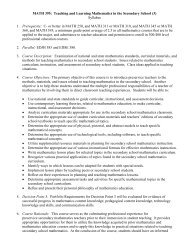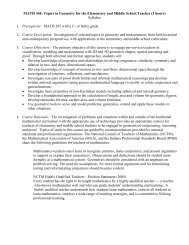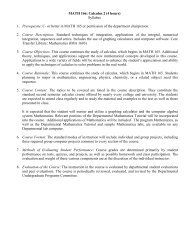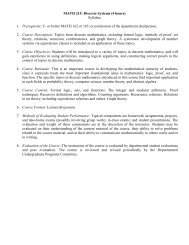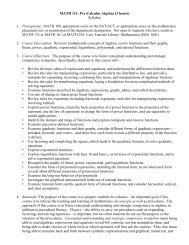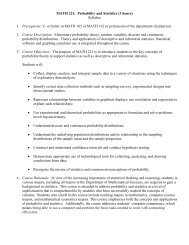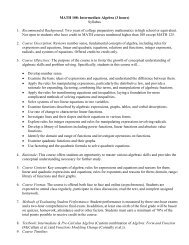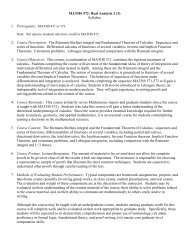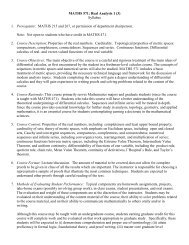MATH 202: Data Analysis, Geometry, and Measurement for the ...
MATH 202: Data Analysis, Geometry, and Measurement for the ...
MATH 202: Data Analysis, Geometry, and Measurement for the ...
- No tags were found...
You also want an ePaper? Increase the reach of your titles
YUMPU automatically turns print PDFs into web optimized ePapers that Google loves.
<strong>Geometry</strong> (7-8 weeks)Basic Terms• Develop geometric language <strong>and</strong> use basic geometric terms to appropriately communicatema<strong>the</strong>matical ideas.• Include language of an in<strong>for</strong>mal deductive nature (all, some, none, if-<strong>the</strong>n, what if).Plane Figures• Measure angles <strong>and</strong> explore relationships between sets of angles.• Classify quadrilaterals using minimum characteristics <strong>and</strong> develop logical arguments about <strong>the</strong>properties.• Classify triangles according to <strong>the</strong>ir sides <strong>and</strong> to <strong>the</strong>ir angles.• Investigate <strong>the</strong> interior, exterior, <strong>and</strong> central angles of regular polygons. Look <strong>for</strong> generalizations.• Use physical models to explore regular <strong>and</strong> semi-regular tessellations, <strong>and</strong> determine whichregular polygons will tessellate.• Use physical <strong>and</strong> visual models to explore reflection <strong>and</strong> rotation symmetry of plane figures.• Construct plane figures using geometric tools (protractor, compass, mira, LOGO).• Use physical <strong>and</strong> visual models to explore congruence <strong>and</strong> similarity.• Formulate <strong>and</strong> solve problems whose solutions require two-dimensional spatial sense.• Use physical <strong>and</strong> visual models to investigate trans<strong>for</strong>mations (slides, flips, <strong>and</strong> turns).Space Figures• Explore properties of prisms, pyramids, o<strong>the</strong>r polyhedra, cylinders, cones, <strong>and</strong> spheres.• Analyze <strong>and</strong> describe regular polyhedra. Look <strong>for</strong> generalizations• Explore reflection <strong>and</strong> rotation symmetry of space figures.• Formulate <strong>and</strong> solve problems whose solutions require three-dimensional spatial sense.<strong>Measurement</strong> (4-5 weeks)Nonst<strong>and</strong>ard <strong>and</strong> St<strong>and</strong>ard Units of Length, Area, <strong>and</strong> Volume• Develop ideas that units to record measure are different from <strong>the</strong> process of measurement itself.• Use st<strong>and</strong>ard <strong>and</strong> nonst<strong>and</strong>ard units to estimate <strong>and</strong> measure various attributes.Customary <strong>and</strong> Metric Units• Present measurement through its historical development.• Provide a variety of experiences with <strong>the</strong> customary <strong>and</strong> metric systems.Area <strong>and</strong> Perimeter: rectangles, squares, parallelograms, triangles, trapezoids, circles, irregular polygons• Develop <strong>the</strong> <strong>for</strong>mulas <strong>for</strong> area <strong>and</strong> perimeter through meaningful activities.• Investigate relationships between area <strong>and</strong> perimeter.• Formulate <strong>and</strong> solve problems whose solutions require two-dimensional spatial sense.Volume <strong>and</strong> Surface Area: polyhedra, prisms, pyramids, spheres, cones• Develop <strong>the</strong> <strong>for</strong>mulas <strong>for</strong> volume <strong>and</strong> surface area through meaningful activities.• Investigate relationships between volume <strong>and</strong> surface area.• Formulate <strong>and</strong> solve problems whose solutions require three-dimensional spatial sense.Pythagorean Theorem• Discover, generalize, <strong>and</strong> communicate conjectures which support <strong>the</strong> Pythagorean Theoremthrough <strong>the</strong> use of area models.• Formulate <strong>and</strong> solve problems whose solutions require <strong>the</strong> Pythagorean Theorem.6. Course Format: Students work individually <strong>and</strong> in small groups to solve problems <strong>and</strong> participate inactivities in class <strong>and</strong> to complete assignments outside of class. Faculty engages students in interactive



